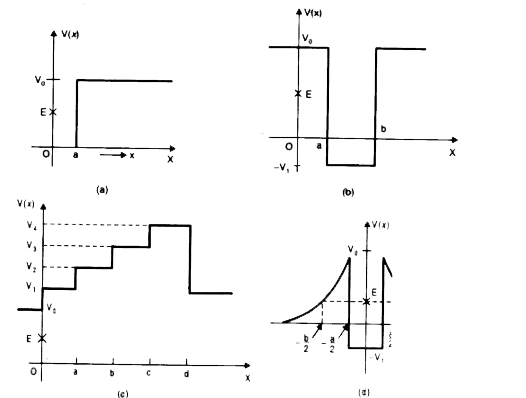Given in fig are examples of some potential energy functions in one dimension. The total enrgy of the particle is indicated by a cross on the ordinate axis. In each case, specify the regions, if any, in which the particle cannot be found for the given energy. Also, indicate the minimum total energy the particle must have in each case. Think of simple physical contexts for which these potential energy shapes are relevant.

We know, that total energy E=K.E+P.E or K.E=E−P.E and kinetic energy can never be negative. The object can not exists in the region, where its K.E. Would become negative. A) IN the region between x=0 and x=a, potential energy is zero. So, kinetic energy will be negative in this region. Thus, the particle cannot be present in the region xgta. The minimum total energy that the particle can have in this case is zero.
Topper's Solved these Questions
Similar Questions
Given in fig are examples of some potential energy functions in one dimension. The total enrgy of the particle is indicated by a cross on the ordinate axis. In each case, specify the regions, if any, in which the particle cannot be found for the given energy. Also, indicate the minimum total energy the particle must have in each case. Think of simple physical contexts for which these potential energy shapes are relevant.

View SolutionThe total energy of a particle executing simple harmonic motion is
View Solution
Knowledge Check
In which case does the potential energy decrease ?
Aon compressing the springBon stretching a springCon moving a body against gravitational pullDon rising of an air bubble in waterThe total energy of particle executing SHM is proportional to
AdisplacementBfrequencyCvelocity at mean positionDsquare of amplitudeThe total energy of particle executing SHM is proportional to
AdisplacementBfrequencyCvelocity at mean positionDsquare of amplitude
A particle of mass m is executing SHM about its mean position. The total energy of the particle at given instant is
View SolutionA particle of mass m executing S.H.M. about its mean position. The total energy of the particle at given instant is
View SolutionThe kinetic energy of the particles is maximum in the case of ____.
View SolutionPotential energy of the particle performing S.H.M. is
View SolutionA particle with total energy E moves in one dimemsional region where the potential energy is U(x) The speed of the particle is zero where
View Solution

